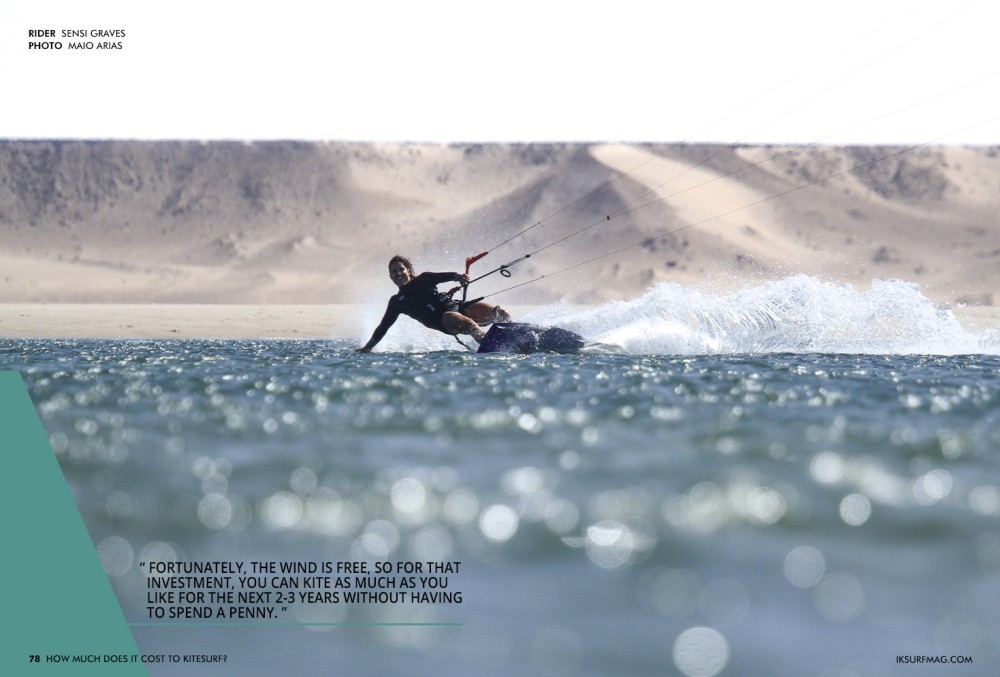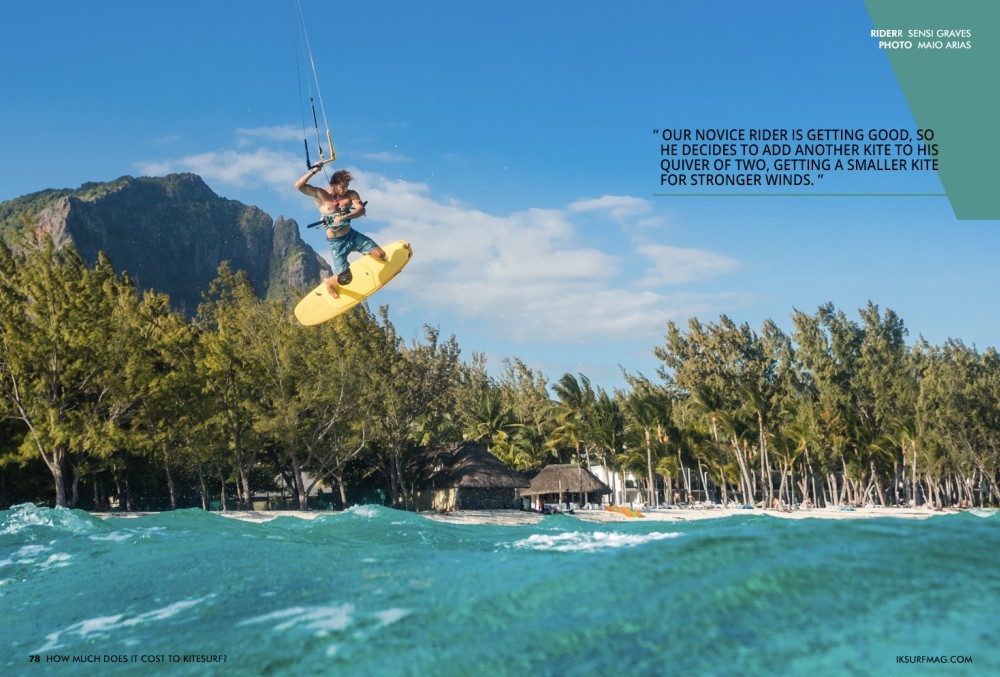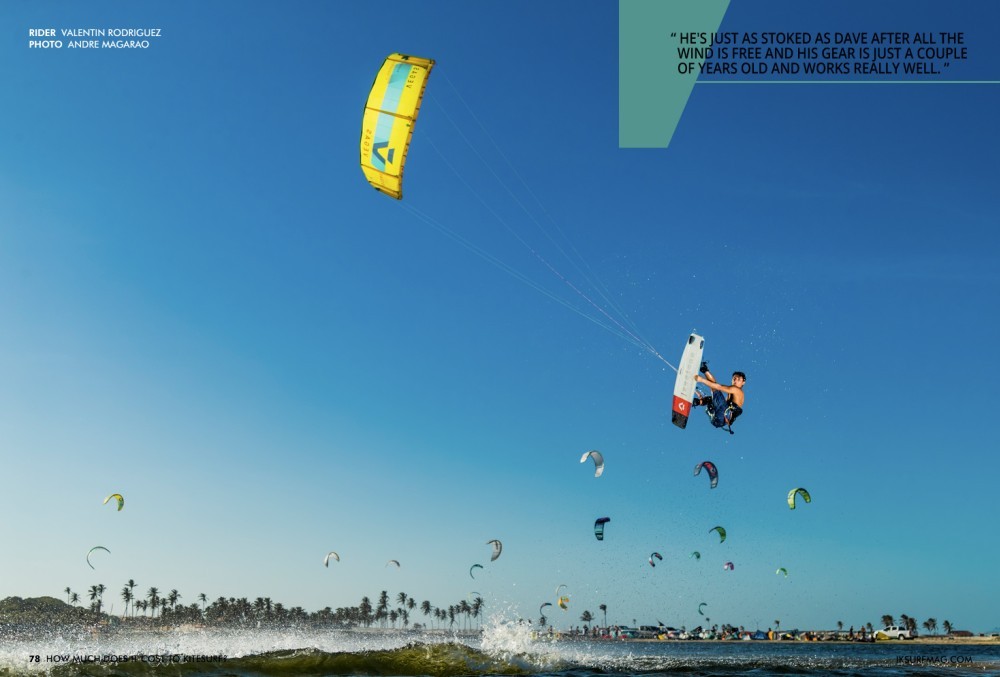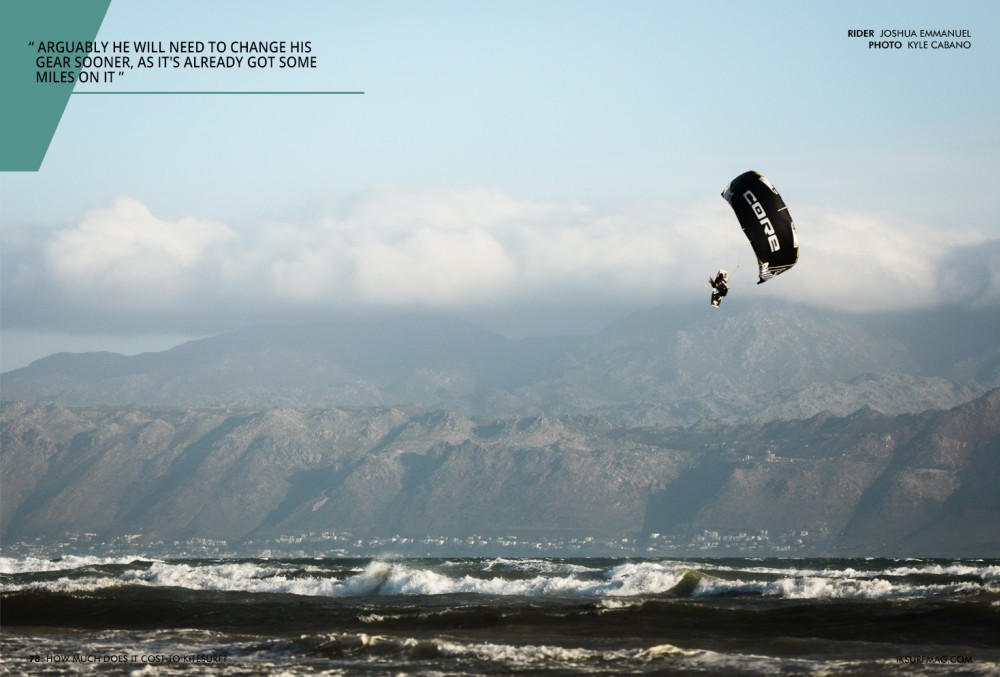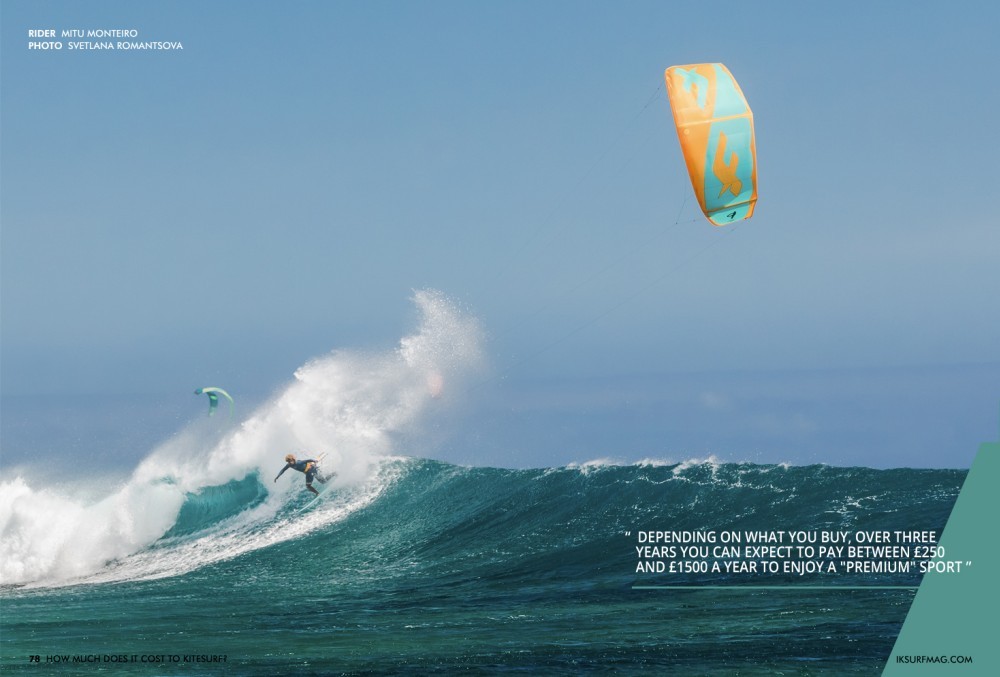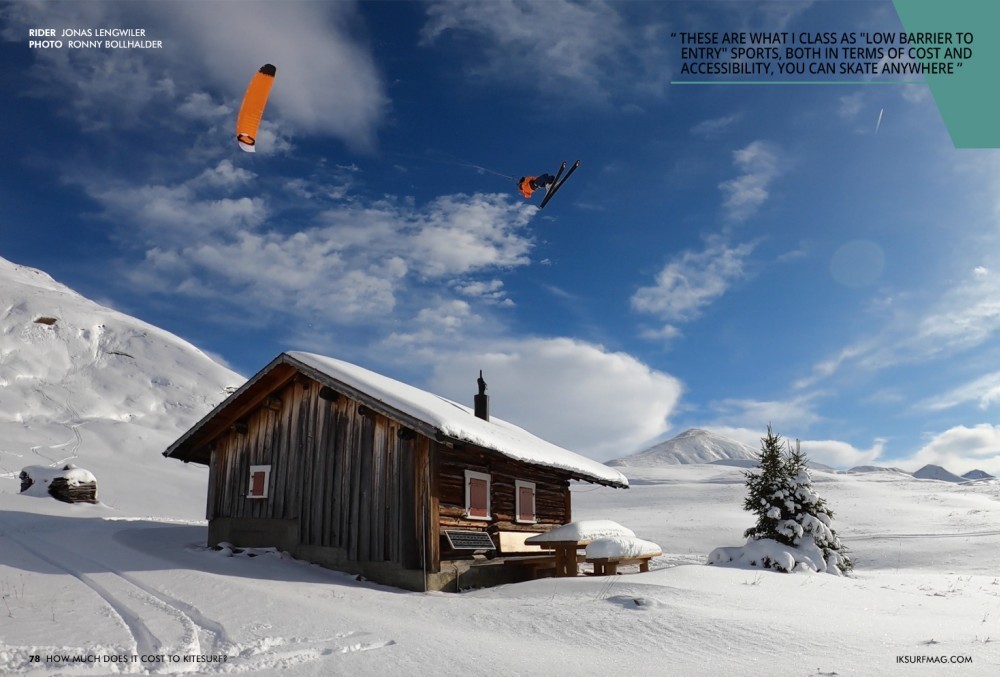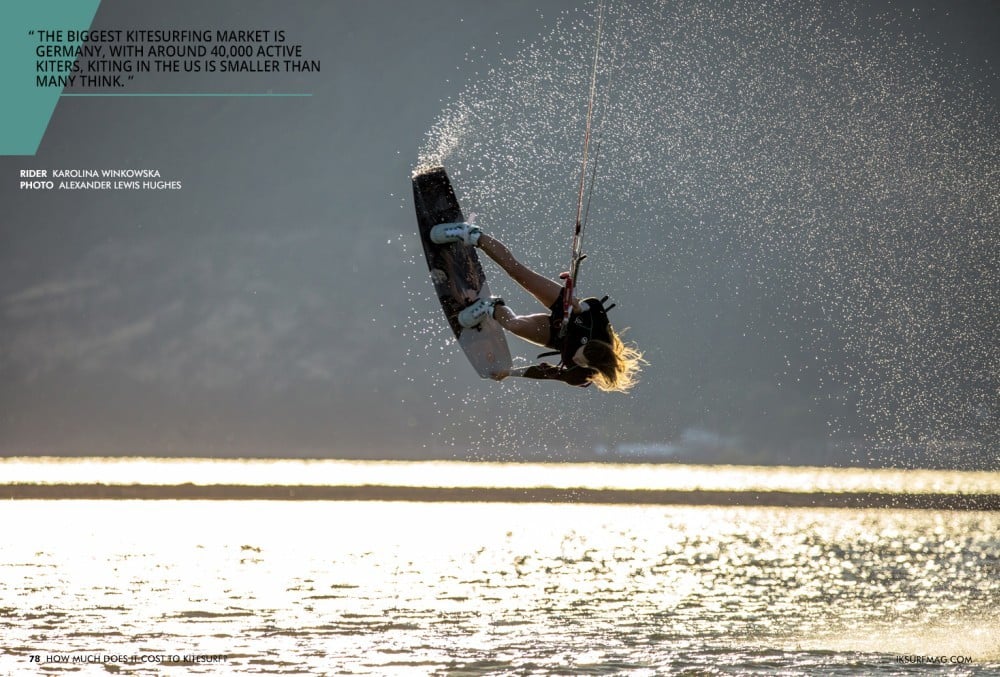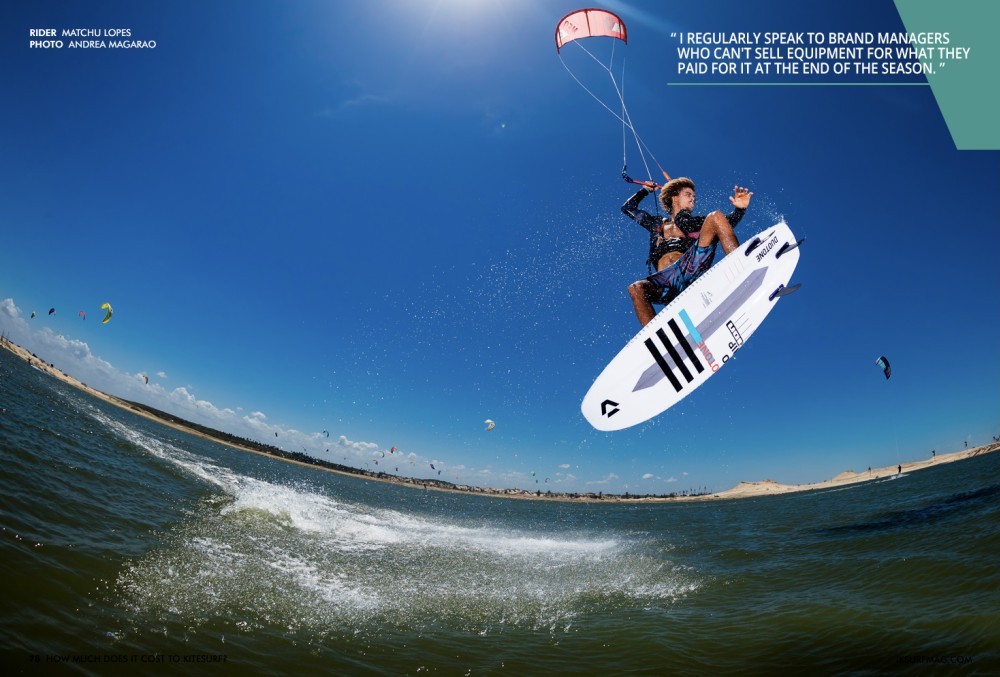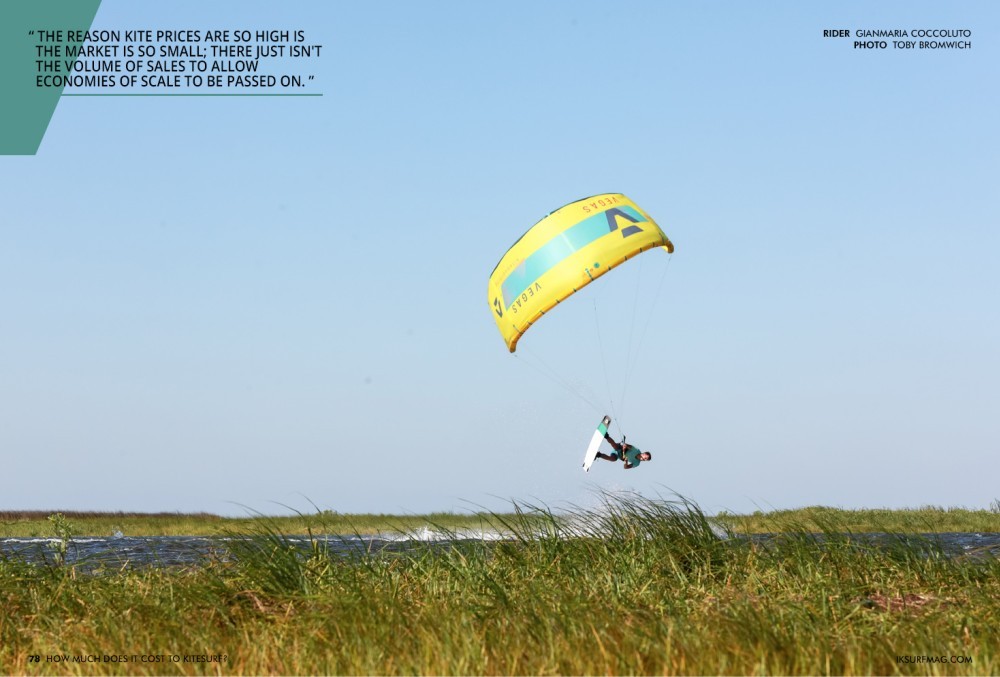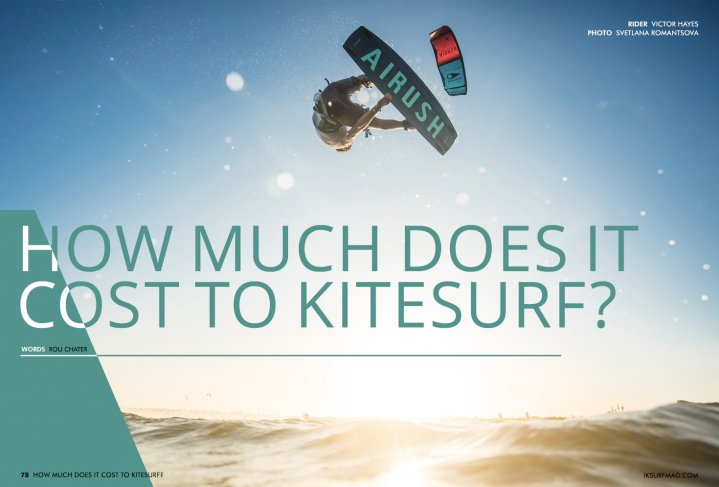
How Much Does It Cost To Kitesurf?
Issue 78 / Wed 11th Dec, 2019
Is kitesurfing expensive? Or is it too cheap? Rou Chater puts his best maths hat on to work out what the real cost of kiteboarding is and comes to some interesting conclusions. If you've ever wondered about the costs of kites, this one is for you...
Rou Chater looks at the costs of becoming a kitesurfer, and how they have increased year on year for new gear, yet seemingly decreased for second-hand products. Is kitesurfing too expensive as many people think, or is it in fact too cheap? Read on to find out…
First up let's get one thing out of the way, kitesurfing isn't a cheap sport. Imagine for an instance that you want to be a kitesurfer, hopefully, the first path you take is getting some proper lessons from a qualified instructor. That's going to set you back between £250 - £350 for a three-day course. You can swap the GBP sign for dollars, or Euros, the numbers globally are mostly the same, just in different currencies. Feel free to do that throughout the article.
A three-day course is widely accepted as being the very minimum you need to become self-sufficient, for argument's sake your instructor says you need an extra day on top of that to feel confident enough to get some gear and head to the beach on your own. Before you've bought a single piece of equipment your into the sport for £350 - £450. Technically you are now a kitesurfer, but you have nothing to kitesurf with…
You're going to need at least two kites, a board, a wetsuit and harness. Getting a package deal on new gear from a reputable dealer is going to set you back between £2500 and £3000. I've based that on a package deal of a 9m kite, bar and board from a premium brand with an extra 12m for light winds added to the basket.
Add another £300 for a basic winter wetsuit and a half-decent harness, after all that is one of the most essential bits of kit in the whole set up. A quick tally at an average of all those prices comes to £400 on lessons, £3000 on gear, at a very rough investment of £3400 you are now a fully-fledged kitesurfer with a tasty new quiver of beginners gear ready to rock as soon as the wind blows.
Fortunately, the wind is free, so for that investment, you can kite as much as you like for the next 2-3 years without having to spend a penny. (We're ignoring the cost of fuel, parking and holidays for the moment) Kitesurfing gear is pretty durable and these days should last at least 2-3 seasons and still have some resale value too. As we all know though, the correct number of kites and boards you should own is N+1, where N is the number of kites and boards you own, and you can always have more.
Imagine our novice rider is getting good, so he decides to add another kite to his quiver of two, getting a smaller kite for stronger winds. A brand new 7m from a premium brand sets him back a further £1200, he's savvy now and asked for a discount. However, summer rolls around, and the wind disappears, but our new rider still wants to kite, he looks at surfboards, hydrofoils, yet decides, sensibly, that a bigger kite is what he needs to work on his twin tip skills.
A new 15m kite from a premium brand costs him £1600, he's got all the gear needed to cover a wind range of 10 mph to 35 mph, and he's a happy little kitesurfer, so much, so he's busy telling all his friends they should get into it too. He's rocking out some backrolls at the local beach, making new friends and feeling lots of love for the sport.
I am sure a few of you reading this will be scoffing, what about buying second hand! Currently, Dave, let's call him that it will just make things easier, is £6200 into a new sport he loves. He's getting fitter, getting better and enjoying the sport we are so passionate about.
Dave's friend Mike decides he likes this look on his mate's face and he wants to go to the beach and take up this great sport too. Mike gets some lessons, and decides second hand is the way he is going go when it comes to buying gear. He can't get second-hand lessons, but he can get second-hand equipment.
He picks up a second-hand wetsuit for £80, the owner has promised him it's never been pissed in, but he isn't so sure. A harness for £80 is procured from eBay and seems to fit OK. Now he just needs a couple of kites, a bar and a board to get started.
Mike spends ages looking on Kitebay on Facebook and eBay too, he picks up a 9m kite with a bar for £350 it's immaculate and only two years old. He gets a board for £200 and then spots another kite, which is the same brand as the one he has, so will work perfectly with the bar he has. It's only £250, what a steal, he buys it and is all set up to ride.
In total, at this stage, Mike has spent £1360 on lessons and gear. He starts going down the beach with Dave and getting on the water every chance he gets. He's just as stoked as Dave after all the wind is free and his gear is just a couple of years old and works really well.
As Mike gets better, Dave tells him he needs more kites, because, N+1 of course! He is missing out on the light wind sessions Dave enjoys with his 15, and the strong wind ones where Dave pulls out his 7m. Mike hunts the second-hand market and picks up a couple of extra kites. He pays £450 for an older 15m kite, it's three years old, has a couple of tiny pinhole repairs, but it works great. His 7m he gets a bargain for £300 on a kite that is just a year old and in good condition with no repairs.
In total Mike has spent £2110 to become a kitesurfer and now has all the gear he needs for a couple of years riding and a similar set up to Dave. Arguably he will need to change his gear sooner, as it's already got some miles on it, but for argument's sake, he looks after it, and it last him 3 years just like Dave's.
After 3 years both Dave and Mike are getting pretty good at the beach, and they decide it's time to sell their gear and get new kites and boards, they are pros now after all! Dave sticks his equipment on eBay and gets roughly £2110 for it, basically what Mike paid. If you are following this, you'll notice I kept the date ranges similar to make it easier on the maths.
Mike sells his gear and gets guess what gets not far off what he paid for it. He's looked after his kites, and they are in good condition. He holds out and gets just £50 less on each item. Crikey, I feel like a school teacher doing a maths problem at this stage, this isn't really where I wanted to go, but bear with me…
Mike gets £1300 selling his four kites and board, his piss-ridden wetsuit gets recycled (thank goodness, that thing was stinking) and he gave his harness to a kid at the beach for free.
To start kitesurfing, Dave spent £6200, including lessons. When he sold his gear three years later, he got £2110 for it. His three years kitesurfing cost him £4090 or £1363 per year.
Mike, on the other hand, spent £2110 to start kitesurfing, including lessons. When he sold his gear three years later, he got £1300 for it. His three years kitesurfing cost him £810, or £270 per year.
If you haven't worked it out by now, Dave is a banker, and Mike flips burgers for minimum wage, but it's OK as they are both kitesurfers, and that is cool.
The average cost of a gym membership is around £500 per year. Obviously, there are cheaper and more expensive gyms, but I'm trying to keep things simple. Anyway, kitesurfing is way more fun than the gym. A mountain bike will cost between £700 and £6000+ depending on what bike you buy, you don't need lessons, and it's free to use like kitesurfing (I'm being very liberal with fuel and parking charges).
John doesn't like the sea, so he buys a mountain bike instead. He's not a banker, but he's not flipping burgers either, he earns an average wage, and he gets an averagely priced mountain bike. It costs him £3000, he spends a further £400 on helmets, shoes, pads and clothes. He's £3400 in and rides his bike for three years and sells it for £1200. It's cost him £2200 to ride his bike for three years or £733 a year.
We could run the sums on any number of fun sports, all with similar outcomes, motocross, paragliding, windsurfing, wingsurfing, SUP. They all fall into the premium sports category, where you have to pay a considerable entry fee to play, or you go the second-hand route. Depending on what you buy, over three years you can expect to pay between £250 and £1500 a year to enjoy a "premium" sport.
Non-premium sports, surfing, skateboarding etc. all involve a minimal outlay for entry. Arguably this contributes to their success. A surfboard isn't an overly expensive item, and a skateboard is even less to purchase. There isn't a lot that goes into these products aside from raw materials and the knowledge of the shaper (invaluable by the way). With the advantage of economies of scale, you can drive down the price too.
400,000 surfboards are sold each year, in what is a 4 billion dollar industry. Although there are an estimated 35 million surfers worldwide, which goes to show how few boards they buy! Regardless of what surfers spend the sport is enormous. Skateboarding is a 4.8 billion dollar industry in North America alone, and there are an estimated 11 million skateboarders worldwide.
These are what I class as "low barrier to entry" sports, both in terms of cost and accessibility, you can skate anywhere (as long as it isn't banned). Just running the numbers, it is easy to see why skating and surfing flourish so much, and these are still niche sports. To give you an idea of the numbers involved the global sports market as a whole was worth $471 billion in 2018. Skateboarding and surfing, arguably the two biggest action sports make up just over 8 billion of that market, a tiny fraction, only 1.7%.
Kiteboarding is what I would class as a high barrier to entry sport. Firstly you have to have access to wind and water, two things we all know don't often go together. Then you have to have access to lessons and the disposable income to buy equipment. Not to mention a will to risk life and limb and take up what is essentially a sport that can potentially kill you.
In 2017 the total kite market sold around 150,000 kites. Let's consider that Dave bought 4 of those kites, as that's when he got into the sport. The average quiver size is 2, so you could reason there were just 75,000 customers for new gear worldwide. That's not a massive number by any standards; in fact, it is a terrifyingly small figure.
The number of active kitesurfers is a wildly overestimated one, in my opinion. Figures like 1.5 million are cited on the Internet but have no real source. If you look at the numbers of kiters in each country, it really doesn't add up. It might surprise you to know the biggest kitesurfing market is Germany, with around 40,000 active kiters, kiting in the US is smaller than many think.
Running some generous maths I came up with around 285,000 kiters worldwide, looking at the countries with big markets and adding them up, it's not a huge number at all. Even if we doubled that estimate, it's a tiny number compared to surfing and skateboarding. I could arguably write a whole other article about this, but let's get back to the cost of kiteboarding for a moment.
With a high barrier to entry, the number of participants will always be comparatively low, we aren't talking about £150 on a skateboard and helmet and pads here, we're talking serious time, money and location investments to gain access to kiteboarding. This drastically reduces the potential number of people even able to do the sport, let alone the actual number doing it.
Despite those low numbers in total sales for the brands, Mike can access this fantastic sport for three years at a cost considerably less than a gym membership, and poor Dave gets to kite for almost five times that amount. Neither of them mind, because they love to kitesurf. Yet all we hear on social media is that kitesurfing is too expensive…
I'd counter with this, it's not the cost of new gear that is the problem; it's the low cost of second-hand equipment. Before I price Mike out of the sport, hear me out. Dave buys his gear and even if he sells it a year later he will struggle to get even 40-50% of what he paid for it. I regularly speak to brand managers who can't sell equipment for what they paid for it at the end of the season.
There is something seriously wrong when the rep for a brand can't sell a kite second hand and cover his or her costs at the initial purchase. It is EVEN worse for the average guy like Dave buying new gear and watching it shed it's value faster than Tesla share's when Elon's been smoking.
I can't think of another sport where you lose so much money from the purchase price to the second-hand price. Why is that? Brands selling at 50% retail as a business model doesn't help, it instantly means anyone who paid 100% retail can't get 50% second hand as the price will be the same as a new kite mid-way through the season. That's just ridiculous.
An eagerness by sponsored and assisted riders to sell gear at any price is another low driver. Both of these factors combine to drive the second-hand value lower, which in the end just hurts Dave in the pocket. It's great for newcomers to the sport buying second hand, but is it sustainable?
Surely if second-hand gear held its value, it wouldn't be as "expensive" for Dave to kitesurf for three years. He'll still have the initial outlay, but he will recoup more of his investment when he sells. Mike might pay a little more, but even if it cost him twice as much per year to kite that's still less than most gym memberships.
The reason kite prices are so high is the market is so small; there just isn't the volume of sales to allow economies of scale to be passed on. You have the premium brands, investing in R&D, materials, staff, factories, riders etc. Then there are the mid-range brands, investing less but selling less. Finally, the low-cost brands, running small teams and selling kites at a lower price.
These smaller brands can make the larger brands pricing seem crazy, but I do believe you get what you pay for in terms of build quality and after-sales service. At least you should do. The fact there is this choice is excellent, not all running shoes cost the same after all, and why should they.
Regardless of what you pay initially if the price of that second-hand kite drops to just 40% a year later, the value of that product is rapidly diminished. Regardless of the initial outlay, this creates a lower perceived value to you, the consumer, at full retail. In this scenario kites are indeed incredibly expensive, you could argue why on earth would you buy new gear at all?
However, if you bought a kite and year later, it was worth 60% of the price you paid for it, it's a whole different story. Then, if each year that kite shed just 5 or even 10% of its value, it would still be worth a reasonable amount in 3 years when you come to sell it. Stop and think about that for a second…
The low prices of the second-hand market are killing the kite industry. In the worst-case scenario, if it prices everyone out of buying new kites, the total global kite sales fall, the overall value of the market drops and brands fall by the wayside. If that continues, then the future is incredibly bleak, eventually the lack of new kites available means less second-hand kites available and the second-hand price rises, ultimately pricing Mike out of the market and the whole thing collapses. Dave has nothing to buy, Mike can't afford anything, and we all go wingsurfing. God forbid.
This is, of course, a wild fantasy, but it could be a reality, just look at the price of windsurfing gear, it's gone through the roof as the market has shrunk. We teeter on a knife-edge with these niche sports, they can disappear as fast as they appear and it's worth remembering that.
It's an interesting problem. I'd argue kitesurfing isn't expensive, but that the second-hand market is cheap. Sure, the initial outlay for new gear is high, but then so are other premium sports. If that gear could hold it's value for longer, then the sport becomes more balanced as you get more perceived value.
If everyone sold a second-hand kite for 60% of market value when it was one year old, and then only dropped 5-7% each year based on wear and tear, an immaculate 3 year old kite would still be worth 45% of the original value, which is currently more than a year old kite can command.
In that scenario, Mike would pay just a little more to start kitesurfing by about 5% if he bought a 3-year-old kite. Dave would pay the same, but not feel kitesurfing was expensive when he came to sell his gear, and he might even sell it sooner, knowing it would yield a better return.
I think the outcome of a structured second-hand market value is a hugely beneficial prospect to the sport of kiteboarding. The new price of kites isn't going to drop, whether you think it's overpriced or not, the sport is too small to make it any cheaper. We can be thankful there is a range of brands out there to choose from.
However, the brands dropping 50% on new "in-season" product isn't helping anyone. It totally devalues the market value of equipment and if the brands are doing it the rot starts right there. Equally, the people selling gear that's just a year old for 30% of the original value and even less is crippling the market too. For kiteboarding to survive, something has to give.
Personally, I love the sport, would I pay £1000 a year to kitesurf with new gear that I knew was holding its value? Damn right, I would. I expect you would too. Would I pay £500 per year to kitesurf with second-hand gear in good condition? Of course, that's less than I pay to use the gym, and not a huge price to pay to kitesurf I don't think. For me kitesurfing is totally worth it at these costings, heck I'd spend two to three times that to get my fix. It doesn't have to be expensive, but we don't have to hurt ourselves with the pricing either.
Next time you put a kite up for sale consider this, price it at 60% of the new value if it is a year old, then between 10-5% a year depreciation depending on condition… It's not that outlandish, is it? The only way this will change is if brands stop devaluing the market, and we, the consumers, stop shooting ourselves in the foot by offering second-hand gear at equally crazy prices…
Who knows, maybe we're onto something?
Videos
By Rou Chater
Rou has been kiting since the sports inception and has been working as an editor and tester for magazines since 2004. He started IKSURFMAG with his brother in 2006 and has tested hundreds of different kites and travelled all over the world to kitesurf. He's a walking encyclopedia of all things kite and is just as passionate about the sport today as he was when he first started!




